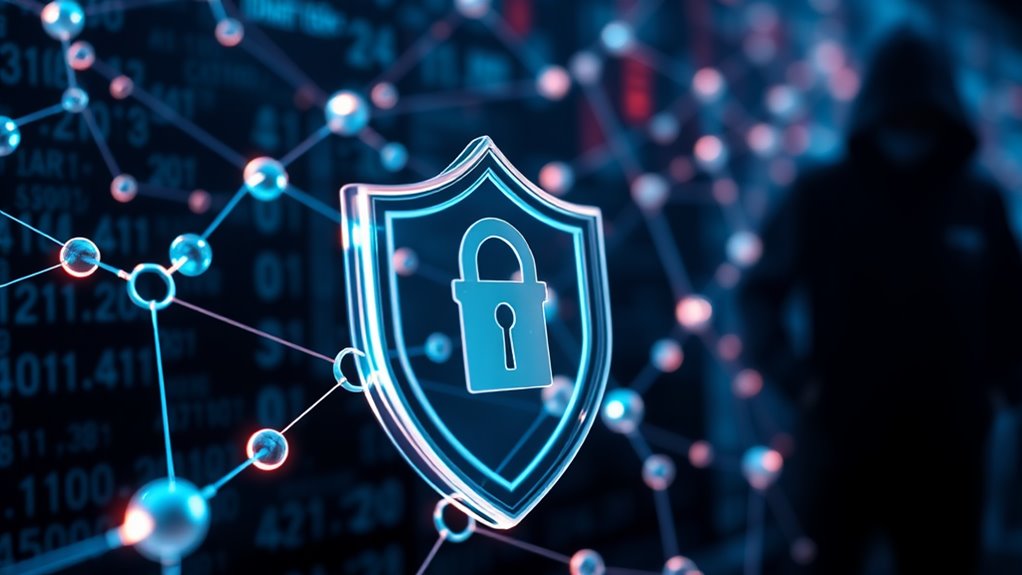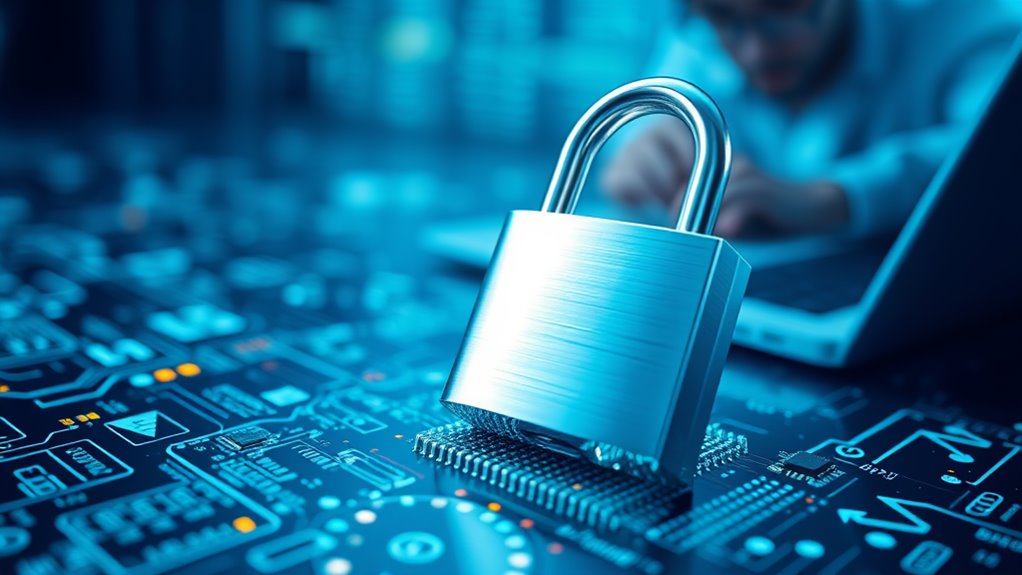
Blockchain Security and Attacks: Essential Insights for Crypto Safety
Blockchain security requires a multi-layered approach focusing on cryptographic protection, consensus mechanisms, and robust network defenses. Common threats include 51% attacks, smart contract vulnerabilities, and network manipulation attempts. Essential security measures encompass hardware wallets, multi-factor authentication, and cold storage solutions for cryptocurrency protection. Regular security audits, automated monitoring systems, and proper private key management help safeguard digital assets. Understanding these fundamental security principles opens the door to thorough blockchain protection strategies.
Key Takeaways
- Hardware wallets and cold storage solutions provide the strongest protection against unauthorized access and online cryptocurrency theft.
- Regular smart contract audits and automated security tools are crucial to prevent exploits like reentrancy attacks and access control vulnerabilities.
- Multi-factor authentication combined with strict private key management significantly reduces the risk of unauthorized account access.
- Network attacks like 51% attacks and timestamp manipulation can be mitigated through robust consensus mechanisms and multi-node defense.
- Emerging quantum computing threats and AI-powered malware require constant security updates and implementation of advanced encryption algorithms.
Understanding Blockchain Security Fundamentals

While blockchain technology has revolutionized digital transactions, understanding its security fundamentals remains crucial for effective implementation and protection of assets. The technology relies on five key pillars that work together to create a secure environment: decentralization, cryptography, consensus mechanisms, immutability, and transparency.
These pillars support critical security features that protect blockchain networks from unauthorized access and tampering. Cryptographic techniques guarantee data integrity and user privacy, while decentralization eliminates single points of failure.
The consensus mechanisms maintain network agreement and prevent malicious activities by aligning participant incentives. Additionally, the immutable ledger ensures that recorded transactions cannot be altered, creating a permanent and verifiable record.
This combination of features establishes a robust security framework that makes blockchain networks resilient against various forms of cyber attacks. The distributed ledger system enables network nodes to independently verify and validate all transactions, strengthening the overall security architecture.
Common Attack Vectors in Blockchain Networks

Blockchain networks face significant security challenges, with the 51% attack representing one of the most severe threats when malicious actors gain control of over half the network's computational power.
While 51% attacks can potentially enable transaction manipulation and double-spending, the substantial computing resources required make them less common in large, established networks.
Smart contract vulnerabilities present equally concerning risks, as coding defects, logic flaws, and design bugs can lead to unauthorized fund transfers and contract manipulation, potentially resulting in substantial financial losses for users and organizations.
These security risks underscore the importance of implementing cryptographic validation mechanisms to ensure the integrity of automated transactions across blockchain networks.
51% Attack Network Risks
As cyber threats continue to evolve, attack vectors in blockchain networks present significant security challenges for organizations and users alike.
Network manipulation tactics, including the interception of communications and disruption of node synchronization, pose substantial risks to blockchain integrity. Malicious actors employ various techniques to compromise network operations, from tampering with transaction verification processes to deploying coordinated attacks on infrastructure.
Common attack methods involve the use of malicious nodes to divert transactions and manipulate network timestamps, affecting the synchronization between legitimate nodes.
Attackers may also hack individual nodes to alter verification processes, potentially compromising the entire network's security.
These threats underscore the importance of implementing robust security measures and maintaining vigilant monitoring of network activities to detect and prevent potential breaches.
Implementing hardware wallet protection represents a critical defense against network-based attacks by keeping private keys isolated from vulnerable online environments.
Smart Contract Vulnerability Points
Smart contract vulnerabilities represent critical weak points in blockchain networks, exposing decentralized applications to various forms of exploitation and financial loss. Key vulnerability points include reentrancy attacks, where malicious actors repeatedly call functions to drain funds, and access control exploits that enable unauthorized operations.
Mathematical errors in calculations and signature replay attacks further compromise contract integrity.
Notable exploits have demonstrated the severity of these vulnerabilities, such as The DAO hack resulting in $60 million losses and the Poly Network heist exceeding $600 million. These incidents highlight the importance of implementing robust security measures, including regular code audits, automated security tools, and formal verification processes.
The impact extends beyond immediate financial losses, affecting market stability and undermining trust in blockchain ecosystems, particularly in the rapidly growing DeFi sector. Implementing two-factor authentication provides an essential security layer for protecting cryptocurrency assets from unauthorized access and potential smart contract exploits.
Essential Security Measures for Crypto Protection

Many critical security measures must be implemented to protect cryptocurrency assets effectively in today's digital landscape. Extensive protection requires a multi-layered approach involving secure wallet management, network security protocols, and robust access controls.
Organizations and individuals must prioritize both technical safeguards and operational security practices to minimize vulnerabilities.
- Hardware wallets provide superior protection through offline storage and encrypted key management.
- Multi-factor authentication and role-based access control enhance account security.
- Regular network audits and security updates prevent exploitation of vulnerabilities.
- Cold storage solutions protect long-term holdings from online threats.
- Transaction monitoring and alerts enable quick response to suspicious activities.
Understanding that private keys are the crucial element securing access to cryptocurrency funds, rather than storing actual coins, is fundamental to implementing effective security measures.
These fundamental security measures, combined with proper education and regulatory compliance, form a strong foundation for protecting digital assets in the evolving cryptocurrency landscape.
Smart Contract Vulnerabilities and Preventions

While robust wallet security forms the foundation of cryptocurrency protection, the integrity of blockchain systems heavily depends on secure smart contract implementation.
Common vulnerabilities include reentrancy attacks, access control issues, and oracle manipulation, which have led to significant financial losses in the crypto space. Notable incidents like the Poly Network hack and Parity Wallet incident highlight the severe consequences of smart contract vulnerabilities.
Smart contract exploits have cost the crypto industry billions, exposing critical weaknesses in blockchain security infrastructure.
To prevent such exploits, developers implement various security measures, including the Checks-Effects-Interactions pattern, role-based access control, and regular code audits.
The adoption of secure libraries and fail-safe mechanisms further strengthens contract security. As the blockchain industry evolves, advanced tools, AI-powered audits, and standardized security practices are emerging to enhance smart contract reliability and protect users' assets.
Implementing Proof of Stake consensus mechanisms can provide additional security layers while maintaining energy efficiency in smart contract platforms.
Best Practices for Private Key Management

Private key management stands as the cornerstone of blockchain security, requiring a thorough approach that combines secure storage practices, regular monitoring, and strict access controls. Organizations must implement extensive strategies that incorporate hardware security modules, automated key rotation, and robust access tracking systems.
These measures, combined with strict adherence to security protocols and regular audits, help maintain the integrity of private keys throughout their lifecycle.
Key aspects of effective private key management include:
- Implementation of Hardware Security Modules (HSMs) for secure key storage
- Regular automated key rotation to minimize exposure risks
- Strict access controls based on the principle of least privilege
- Continuous monitoring for anomalies and unauthorized access attempts
- Secure key deletion protocols when keys are no longer needed
Implementing Robust Network Defense Strategies

Robust network defense strategies form the foundation of extensive blockchain security, requiring a multi-layered approach that combines decentralized architecture, advanced cryptographic techniques, and collaborative defense mechanisms. Multiple nodes work together to detect and respond to threats, while distributed storage enhances resilience against attacks.
| Defense Component | Security Benefit |
|---|---|
| Multi-Node Defense | Eliminates single points of failure |
| Real-Time Monitoring | Enables rapid threat detection |
| Consensus Protocols | Maintains network agreement |
| Cryptographic Tools | Guarantees data integrity |
| Threat Intelligence | Improves response capabilities |
Implementation requires significant resources but offers thorough protection against various network threats, including DDoS attacks, man-in-the-middle attempts, and network partition attacks. Regular security audits and policy updates guarantee the defense system remains effective against evolving threats while maintaining operational efficiency. The integration of decentralized finance protocols with robust security measures has revolutionized traditional banking by reducing transaction costs while maintaining high-level protection.
Emerging Threats in the Blockchain Ecosystem

Building upon established network defense strategies, the blockchain ecosystem faces an evolving landscape of sophisticated threats that demand continuous adaptation and enhanced security measures.
Two critical challenges dominate the horizon: quantum computing's potential to compromise cryptographic security and the rise of AI-driven attacks. Organizations must prepare for quantum-resistant encryption while simultaneously defending against automated threats that leverage artificial intelligence for enhanced effectiveness.
Modern security faces dual threats: quantum computing's cryptographic risks and AI-powered attacks require innovative defensive strategies.
- Quantum computers threaten current cryptographic standards like RSA and ECC
- AI-powered malware adapts dynamically to security measures
- Insider threats require strict access controls and continuous monitoring
- Regulatory compliance demands constant vigilance and adaptation
- Smart contract vulnerabilities expose networks to exploitation risks
These emerging threats underscore the importance of proactive security measures and the need for ongoing technological advancement in blockchain defense systems.
Consumer protection measures must be carefully balanced with technological innovation to ensure the sustainable growth of cryptocurrencies.
Advanced Security Technologies for Blockchain Systems

As blockchain networks continue to expand and evolve, advanced security technologies have become essential components in safeguarding digital assets and maintaining system integrity.
Modern blockchain systems employ sophisticated cryptographic techniques, including multi-signature schemes and homomorphic encryption, to protect transactions and data. Zero-knowledge proofs enable transaction verification while preserving privacy, while threshold cryptography distributes private keys to prevent unauthorized access.
Network security is enhanced through continuous monitoring, robust consensus mechanisms, and traffic filtering systems that defend against DDoS attacks.
Smart contract security relies on rigorous code auditing, formal verification processes, and automated security scanning. Additionally, data integrity is maintained through advanced encryption algorithms, cryptographic hash functions, and digital signatures, creating a thorough security framework that guarantees the reliability and trustworthiness of blockchain systems.
Frequently Asked Questions
How Do Quantum Computers Potentially Threaten Current Blockchain Encryption Methods?
Quantum computers can break current blockchain encryption by leveraging qubits to rapidly solve complex mathematical problems that underpin cryptographic security, potentially compromising private keys, digital signatures, and transaction integrity in blockchain systems.
What Recovery Options Exist if a Hardware Wallet Manufacturer Goes Bankrupt?
Ironically, a manufacturer's bankruptcy barely matters. Users can recover funds using their seed phrase with any compatible wallet, as standardized BIP39 protocols guarantee access remains possible across multiple hardware and software solutions.
Can Blockchain Networks Function Effectively During Widespread Internet Outages?
Blockchain networks can maintain functionality during internet outages through decentralized node distribution and alternative connectivity methods. While operations may slow, the system's redundancy and global presence guarantee continued transaction processing and data integrity.
How Do Different Countries' Blockchain Regulations Affect Cross-Border Transaction Security?
Varying national regulations create complex security challenges in cross-border blockchain transactions. Different KYC requirements, encryption standards, and compliance protocols force operators to navigate multiple frameworks, potentially introducing vulnerabilities at regulatory intersection points.
What Environmental Impacts Do Blockchain Security Measures Have on Energy Consumption?
Blockchain security measures, particularly proof-of-work mining, consume significant energy resources. Mining operations require extensive computational power, contributing to high electricity usage and generating substantial e-waste through hardware replacement and obsolescence.
Conclusion
Blockchain security remains a critical priority as the cryptocurrency market continues to expand, with cyber attacks resulting in over $3.8 billion in losses during 2022 alone. Understanding fundamental security principles, implementing robust protection measures, and staying informed about emerging threats are essential for safeguarding digital assets. As blockchain technology evolves, the integration of advanced security protocols and best practices will determine the long-term stability and trustworthiness of cryptocurrency systems.












